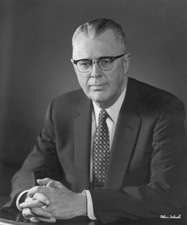Norris Cotton
| Norris Cotton | |
|---|---|
 | |
| United States Senator from New Hampshire | |
|
In office November 8, 1954 – December 31, 1974 | |
| Preceded by | Robert W. Upton |
| Succeeded by | Louis C. Wyman |
|
In office August 8, 1975 – September 18, 1975 | |
| Preceded by | Louis C. Wyman |
| Succeeded by | John A. Durkin |
| Member of the U.S. House of Representatives from New Hampshire's 2nd district | |
|
In office January 3, 1947 – November 7, 1954 | |
| Preceded by | Sherman Adams |
| Succeeded by | Perkins Bass |
| Member of the New Hampshire House of Representatives | |
|
In office 1923 1943–1947 | |
| Personal details | |
| Born |
Norris Henry Cotton May 11, 1900 Warren, Grafton County New Hampshire, USA |
| Died |
February 24, 1989 (aged 88) Lebanon, Grafton County New Hampshire, USA |
| Resting place |
School Street Cemetery Lebanon, Grafton County New Hampshire, USA |
| Political party | Republican |
| Spouse(s) |
Ruth Isaacs Cotton Eleanor Coolidge Brown Cotton |
| Parents |
Henry Lang Cotton Elizabeth (Moses) Cotton |
| Alma mater |
Wesleyan University The George Washington University |
| Profession |
Lawyer Politician |
| Religion | Congregationalist |
Norris H. Cotton (May 11, 1900 – February 24, 1989) was an American Republican politician and a United States Representative as well as United States Senator from the state of New Hampshire.
Early life
Cotton was born on a farm in Warren, New Hampshire, and was educated at Phillips Exeter Academy in New Hampshire and Wesleyan University in Connecticut. While in college, he served as a clerk to the New Hampshire State Senate. He also served as a member of the New Hampshire House of Representatives in 1923 as one of the youngest legislators in history. He became a lawyer after attending The George Washington University Law School and practiced law in Lebanon, New Hampshire.
Career
Cotton was elected to the New Hampshire House of Representatives again in 1943, and served as majority leader that year and as Speaker during 1945-1947.
In 1946 Cotton was elected to the United States House of Representatives from New Hampshire for the first time. He served until 1954 when he ran for a seat in the United States Senate from New Hampshire in a special election to fill the vacancy caused by the death of Charles W. Tobey. He was elected to a full term in 1956, reelected twice and served in the Senate until 1975.
One of his most controversial votes came when he was the only senator from New England to vote against the Civil Rights Act of 1964. However, Cotton would vote for later civil rights acts such as the Voting Rights Act of 1965 and the Civil Rights Act of 1968. He was a prominent leader of his party in the Senate, chairing the Senate Republican Conference from 1973 to 1975. He did not run for reelection in 1974. Three days before his final term ran out Cotton resigned to allow the governor to appoint Louis C. Wyman.
Cotton was reappointed to the Senate in August 1975 after the election of his successor was contested. The closest Senate election in history, it went through two recounts at the state level, followed by protracted debate on the Senate floor, until both candidates agreed to a special election.[1] Cotton served as a temporary senator until the September 1975 special election, the result of which was not challenged. Cotton returned to Lebanon, New Hampshire.
Death and legacy
Cotton died on February 24, 1989, (age 88 years, 289 days) in Lebanon. He is interred at School Street Cemetery, Lebanon, Grafton County, New Hampshire.
The comprehensive cancer center at Dartmouth-Hitchcock Medical Center in Lebanon is named for him, and the federal building in Manchester, New Hampshire, also bears his name. There is a historical marker in Warren, New Hampshire, which was unveiled in 2012, and says his rise from humble beginnings embodies the American way of life.[2]
Family life
Son of Henry Lang and Elizabeth Moses Cotton, he married Ruth Isasaacs on May 11, 1927, and the couple had no children. Ruth died in 1978 and he married Eleanor Coolidge Brown in 1980.[3]
References
- ↑ "U.S. Senate: Art & History Home > Historical Minutes > 1964-Present > Closest Election in Senate History". Senate.gov. Retrieved 2010-05-14.
- ↑ "Norris Cotton". Copyright 2012 Associated Press. Retrieved 22 July 2014.
- ↑ "Norris H. Cotton". 2013 The New York Times Company. Retrieved 22 July 2014.
External links
- United States Congress. "Norris Cotton (id: C000802)". Biographical Directory of the United States Congress.
- U.S. Senate Historical Office, "Closest Election in Senate History", retrieved November 15, 2006.
- Norris Cotton at Find a Grave
| United States House of Representatives | ||
|---|---|---|
| Preceded by Sherman Adams |
Member of the U.S. House of Representatives from New Hampshire's 2nd congressional district 1947 – 1954 |
Succeeded by Perkins Bass |
| United States Senate | ||
| Preceded by Robert W. Upton |
U.S. Senator (Class 3) from New Hampshire November 8, 1954 – December 31, 1974 Served alongside: Styles Bridges, Maurice J. Murphy, Jr., Thomas J. McIntyre |
Succeeded by Louis C. Wyman |
| Preceded by Louis C. Wyman |
U.S. Senator (Class 3) from New Hampshire August 8, 1975 – September 18, 1975 Served alongside: Thomas J. McIntyre |
Succeeded by John A. Durkin |
| Party political offices | ||
| Preceded by Margaret Chase Smith |
Chairman of the Senate Republican Conference 1973–1974 |
Succeeded by Carl Curtis |
| Political offices | ||
| Preceded by Sherman Adams |
Speaker of the New Hampshire House of Representatives 1945–1947 |
Succeeded by J. Walker Wiggin |
